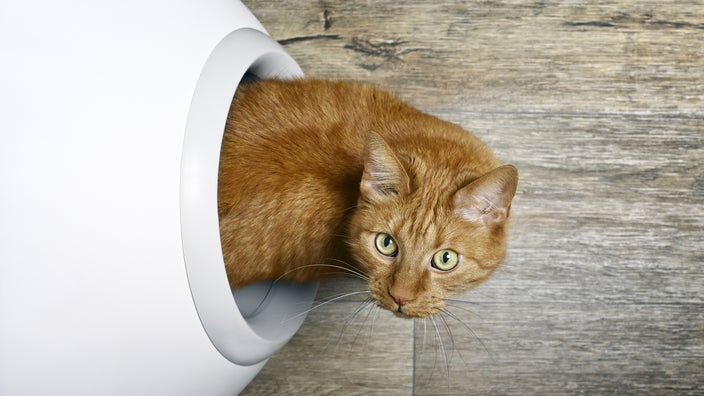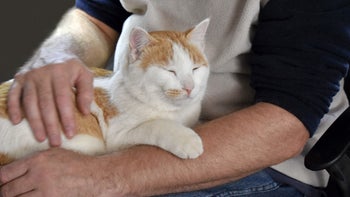
7 Signs Your Cat Has a Urinary Blockage — and Why It’s an Emergency
Key takeaways:
A urinary blockage happens when something — usually a plug of mucus and crystals — blocks a cat’s ability to pee. It is life-threatening and needs immediate care from a veterinarian.
Symptoms of urinary blockages in cats include straining to pee, trying to pee multiple times, and crying in pain.
Treatment for a urinary blockage in cats involves relieving the blockage with a catheter in a hospital.
Table of contents

If a cat has a urinary blockage, something has clogged their urethra. This is what’s preventing them from peeing. Male cats are especially at risk.
Sometimes, it is hard to tell if a cat is experiencing a blockage. But if you suspect your cat has a urinary blockage, take them to a veterinarian immediately. Urinary blockages are life-threatening.
Here are the symptoms to look for.
Save on the top 10 pet medications
Save big on common pet medications like Fluoxetine and Levetiracetam at your local pharmacy.

GoodRx is NOT insurance. GoodRx Health information and resources are reviewed by our editorial staff with medical and healthcare policy and pricing experience. See our editorial policy for more detail. We also provide access to services offered by GoodRx and our partners when we think these services might be useful to our visitors. We may receive compensation when a user decides to leverage these services, but making them available does not influence the medical content our editorial staff provides.
What are the symptoms of a urinary blockage in cats?
Because male cats have a narrow urethra, they are at higher risk of experiencing a blockage than female cats. Some cats may have a partial blockage. Others could have a complete blockage.
Symptoms of a urinary blockage include those listed below.
1. Increased distress
Cats with urinary stones can feel the urge to pee but can’t empty their bladder. As a result, they may show signs of distress, such as restlessness or hiding.
2. Crying in pain
Over time, a cat’s distress can lead to crying in pain. This could include meowing or growling more than usual. They might cry while trying to pee.
3. Not producing much pee, or any
Urinary stones block pee from entering the urethra. So a cat might be able to get only a dribble of pee out. With a complete blockage, they may not pee at all.
4. Straining to pee
When a cat can’t empty their bladder, they could strain while trying to pee in the litter box. It can be mistaken for having trouble pooping.
Urinary tract disease: Cats can have several urinary conditions grouped under the term FLUTD (feline lower urinary tract disease). Here’s what you should know.
Finding a healthy weight: Keeping your cat at a healthy weight can protect them from certain health conditions and pain. Learn what’s best for your cat’s weight.
Litter box woes: Cat not using their litter box? It’s not to spite you. It’s usually a sign of one of these health problems.
5. Bloody urine
In cats who have a blockage, the pee they do produce might have blood in it. This seems to be more common in cats whose blockage is caused by feline lower urinary tract disease (FLUTD), such as feline idiopathic cystitis.
6. Trying to pee in their box multiple times
Along with straining, a cat might try to pee many times because they can’t fully relieve themselves. They might repeatedly get in and out of the litter box. Or they could try to pee outside their litter box.
7. Sudden death
Blockages cause toxic substances to build up in your cat’s blood, usually within 24 hours. A partial blockage can cause death within 3 to 6 days. A complete blockage can result in death in 2 days. Excessive toxic substances can cause symptoms such as:
Vomiting
Lethargy
Heart problems
Read more like this
Explore these related articles, suggested for readers like you.
What causes a cat urinary blockage?
Urinary blockages in cats can be caused by anything that leads to FLUTD. But blockages occur most often because of a urinary plug caused by feline idiopathic cystitis (FIC).
Urinary plugs are soft clumps made of cells, minerals, and mucus that clog the urethra. In cats, FIC is often caused by stress. Male cats are more at risk for blockages because of the length and shape of their urethra.
Blockages can sometimes be caused by urinary stones. Urinary stones are made up of minerals and mucus that harden. The size of stones can vary. If urinary stones are small enough, a cat might be able to pass them when they pee.
Urinary blockages in cats can also be caused by other issues, such as bladder infections or bladder cancer.
How do you treat urinary tract blockages in cats?
Treatment for a urinary blockage in cats involves removing the blockage. The first priority is to try to relieve the blockage so your cat’s pee can flow. Veterinarians do this by placing a catheter — a small tube — into the urethra to flush the blockage.
Your cat needs to be sedated and hospitalized for this procedure. How long your cat stays hospitalized for a blockage depends on the severity of your cat’s condition. Your vet will want to wait until your cat can pee on their own before sending them home.
After the blockage is removed, your cat might make high amounts of pee as the kidneys begin to work again. Your cat will likely be on fluid therapy so they don’t become dehydrated.
Your cat may be given medications for pain such as:
Butorphanol
Acepromazine
In some cases, your veterinarian may recommend a special urinary diet that can dissolve stones in their urine. Cats prescribed a urinary diet usually need to stay on it long term.
If a male cat has chronic blockages, they might need a surgery called perineal urethrostomy. The surgery removes the narrow section of a male cat’s penis to decrease the likelihood of future blockages.
What aftercare is needed for a cat with a urinary blockage?
Your cat’s aftercare following a urinary blockage will require monitoring their symptoms. Cats are at risk of having another urinary blockage 1 to 2 weeks after a blockage is removed. Here’s what to do:
Monitor their pee. It’s important that they continue to be able to pee on their own. They might still strain and have blood in their pee.
Feel their bladder. Blockages can cause the bladder to become bigger and firm. Your veterinarian can teach you how to feel your cat’s bladder through their abdomen.
Give any prescribed medication. They could be for decreasing pain, preventing infection, or helping the bladder contract normally.
Tell your vet about any vomiting or loss of appetite. These could be signs of another blockage.
Recovery from perineal urethrostomy surgery
If your cat is recovering from perineal urethrostomy surgery, there are some things you can do for them after surgery:
Keep them calm. Set up a quiet space for them away from other animals.
Use an Elizabethan collar. This will keep them from licking the incision and possibly causing infection.
Don’t use regular litter. Litter like clay can infect the incision. Shredded newspapers would be best to use for the next 10 days.
Keep all follow-up vet appointments. Cats who get this surgery are more at risk for bladder infections. So they might need regular urine cultures to monitor their health.
How to prevent urinary cat blockage
Preventing urinary blockages in cats depends on the cause behind the blockages. But since FIC is the most common cause of blockages, reducing stress can help prevent future issues.
You can help reduce stress for your cat by:
Enriching your cat’s environment with scratching posts, cat trees, and toys
Having at least one litter box for each cat in your home
Having multiple water bowls or fountains
Having dedicated areas for eating, drinking, sleeping, and playing
Making sure your cat has access to you
Managing their pain during flare-ups
Helping your cat maintain a healthy weight may also help prevent urinary blockages. Ask your cat’s veterinarian for guidance on how to choose the right diet for your cat.
Frequently asked questions
Most cats pee 2 to 3 times per day. This can vary based on your cat’s diet, whether they eat canned or dry food, and any health conditions they may have.
Urinary blockages don’t go away on their own, and they are an emergency. If you suspect your cat has a blockage, do not wait to see if it will go away on its own. A vet can try to pass the stones by applying pressure to the bladder. But most of the time, surgery will be necessary to relieve the blockage.
The bottom line
Urinary blockages in cats are serious and need immediate veterinary care. The symptoms of a blockage include straining to pee and showing signs of distress. Blockages are caused by urinary stones or plugs clogging the urethra. Treating a blockage usually requires hospitalization to remove the blockage and monitor your cat. Your veterinarian likely will recommend a special urinary diet to help prevent future mucus plugs or urinary stones from forming again.
Why trust our experts?



References
American Veterinary Medical Association. (n.d.). Feline lower urinary tract disease (FLUTD).
Brooks, W. (2022). Urinary blockage in cats. Veterinary Partner.
Brooks, W. (2024). Idiopathic cystitis in cats. Veterinary Partner.
Cornell Feline Health Center. (2016). Feline lower urinary tract disease. Cornell University College of Veterinary Medicine.
Dulaney, D. R., et al. (2017). Quantification of urine elimination behaviors in cats with a video recording system. Journal of Veterinary Internal Medicine.
George, C. M., et al. (2016). Feline urethral obstruction: Diagnosis and management. Today’s Veterinary Practice.
Johnson, T. (2022). Blocked cats are an emergency. Veterinary Partner.
Seim, H. B. (2018). Feline perineal urethrostomy: A novel approach. World Small Animal Veterinary Association Congress Proceedings.
Walden, L. A., et al. (2019). Unblock that cat, STAT! DVM360.


























